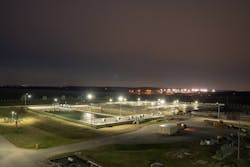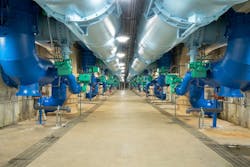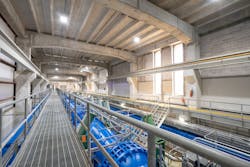About the author:
Cristina Tuser is Associate Editor for Water & Wastes Digest. Tuser can be reached at [email protected].
At the A.B. Jewell Water Treatment Plant in Tulsa, Oklahoma, raw water from Lake Oologah flows into the system for processing. John Curry is currently the facilities maintenance manager of the plant.
The Plant at a Glance
The plant has a capacity of 120 million gallons per day (mgd). The plant pumps water from Oologah Lake to a reservoir across the street from the facility and the reservoir has intake structures, which the plant can gravity flow across the street to the facility.
The treatment plant houses four clarifiers, media filters with sand and granular activated carbon (GAC) and seven high service pumps, four of which are rated for 30 mgd and the remaining three for 20 mgd.
According to Curry, the plant tries to shoot for enough chloramines to maintain 2.4 mg/L at the end of the system, which is the standard that the state has to follow. The plant meets the state requirements set by the Oklahoma Department of Environmental Quality, but any local requirements are equal to or better than the state standard.
Algae and zebra mussels from Oologah Lake are the main challenge the plant faces, Curry said. The zebra mussels in particular multiply, find their way into the pumps and clarifiers, and eventually settle out in the sludge. For now, these are the only treatment issues that plant is running into.
Push for Predictive Maintenance
Curry has been with A.B. Jewell for almost six years. The previous maintenance supervisors took a reactive approach to issues at the plant, according to Curry.
“They run it till it fails mentality causes problems,” he said. “We’re trying to strive for a predictive maintenance program, where we can see a trend and see degradation, long before we get to the panic point.”
So far, Curry and his team have been successful in migrating data into an asset management software system to monitor equipment and budget for potential replacements. By doing this, the team is increasing the operation’s ability to properly treat the water, since it does not have to reroute a process or make adjustments constantly.
This system alone has saved thousands of dollars in maintenance costs.
“Catastrophic failure is more expensive than changing something before it explodes,” Curry said.
Curry has 10 people working alongside him at the plant. The team is comprised of mechanics, electricians, plumbers, instrumentation specialists, and SCADA and PLC specialists. When they are not working in the designed field, they’re assisting the other trades and crafts.
The city of Tulsa started a maintenance reliability of team with select individuals across the city through the water and sewer department, forming a committee with the intention to develop and locate local and inexpensive training for different trades. As a result, the plant has a written program and in-house standard operating guidelines and maintenance guidelines.
“We write those guidelines about the jobs that we do, keeping them in our online library,” Curry said. “New employees can come in and see a task that they are working on in written form and then they can go out with someone who is trained in that task and see it done. It keeps morale high.”
Expansion Plans
The plant is in the process of getting an upgrade in order to increase capacity to 150 mgd. When LED technology became more prevalent in the industry, Curry and his team saw a benefit in migrating to LEDs. As a result of this shift, the plant has eliminated all of the labor involved with changing fluorescent bulbs.
“I have not had any lights to speak of give me any failures since installation,” Curry said. “I’ve had complete, 100% LEDs in the plant for about three years now.”
To date, the facility has installed more than 600 Dialight LED light fixtures in several areas to replace a mix of outdated lighting.
Before the upgrade, the A.B. Jewell staff began researching the options and selected a few LED samples for a fixture trial. They decided on Dialight’s LED StreetSense streetlights and Vigilant High Bays, Low Bays, Flood Lights and Area Lights.
The plant’s electricians replaced the 350 existing lights, ranging from 70 to 400 watts, with just 259 Dialight LEDs, ranging from just 33 to 212 watts. They were they able to reduce the total fixture count, and the change out slashed 446,576 kWh from the plant’s annual consumption. Most importantly, the upgrade dramatically improved the brightness and quality of light in and around the facility.


